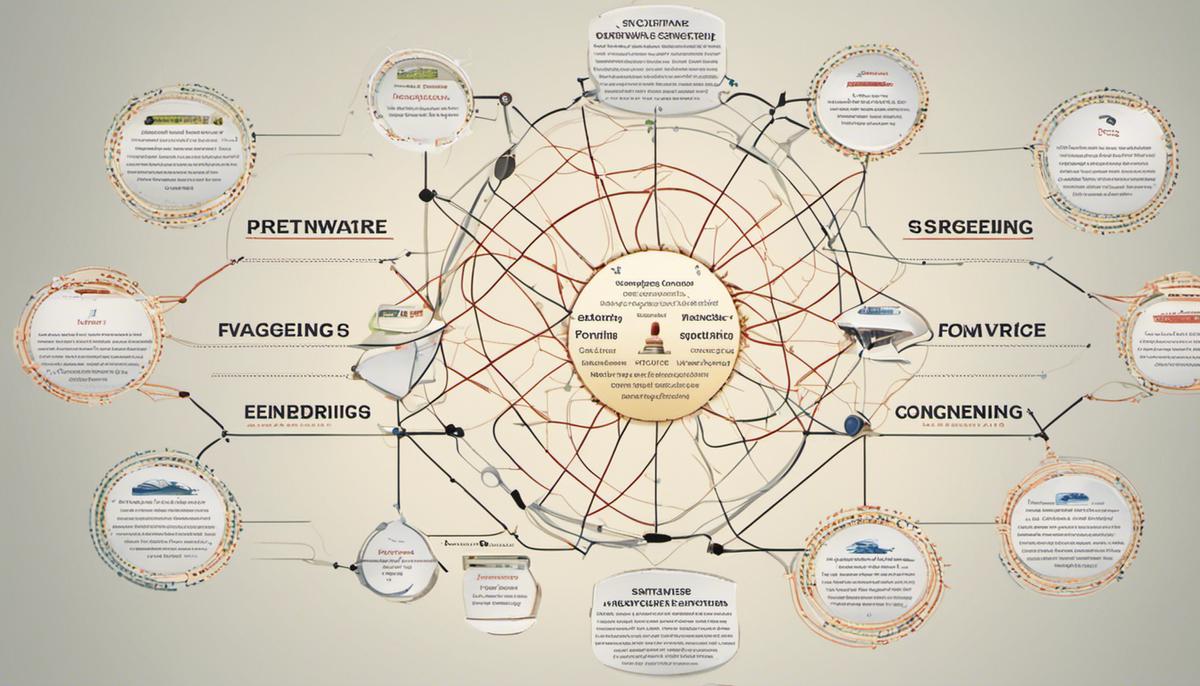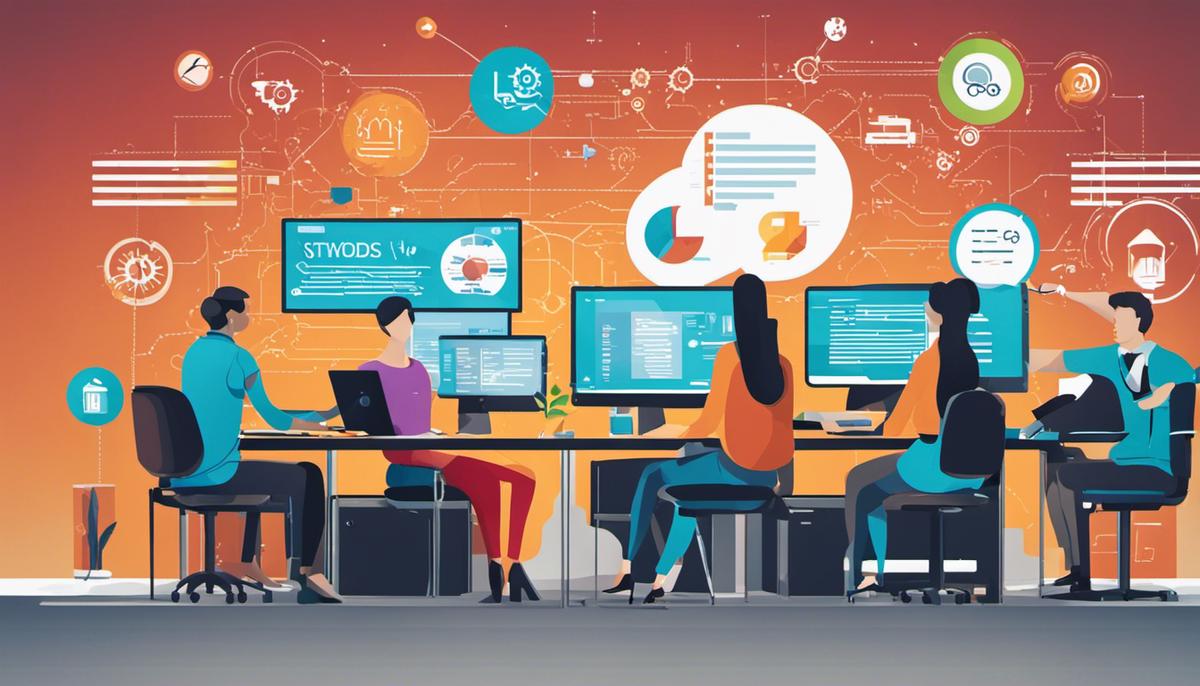In the contemporary world where technology dominates every aspect of life, the concepts of software engineering vs software development come to the forefront. As complex and interconnected branches of the vast realm of technology, they play an indispensable role in shaping the IT landscape. This article explores these two domains, delving into their main characteristics, delineating their foremost differences and highlighting the commonalities. It equips you with a perceptive understanding, drawing upon topics from the principles of software engineering to the intricate processes of software development, culminating in real-world applications. By breaking down these tech entities paired with highlighting potential career paths, the article strives to equip the reader with a comprehensive understanding.
Understanding Software Engineering
Understanding the Core Principles of Software Engineering: Insights for the Modern Tech Enthusiast
Software engineering, a critical field in our tech-driven world, hinges on a set of core principles to guide the development and maintenance of software systems. A deep dive into these principles provides invaluable wisdom for tech enthusiasts interested in software development’s nitty-gritty, nudging them towards better problem-solving and process automation in this ever-evolving landscape.
Firstly, one cannot deny the importance of continual learning, given the dynamic nature of technology and software engineering. Understanding that no single technology will dominate forever is essential. Languages, databases, and methodologies are all subject to rapid change. Therefore, becoming a lifelong learner open to new ideas and technologies enables engineers to adapt to these changes proficiently.
The second principle is simplicity. It’s the key principle behind some of the most efficient and clean codebases. A complex system doesn’t always need a complex solution. In fact, the simpler the code, the fewer the chances for bugs and errors during the development process. Crafting simple, understandable, and maintainable code is critical to long-term success in software creation.
Equally pivotal is the understanding and application of abstraction and modularization. Abstraction allows a software engineer to ignore the irrelevant details and focus on the most relevant ones. Combining this with modularization, which is the division of a system into separate, manageable modules, can greatly simplify complex tasks, making the process more efficient.
One principle that often underscores productive software engineering practices is robustness. As software engineers, designing resilient systems capable of handling unexpected situations without crashing or causing serious performance issues should always be a priority. This facet is particularly vital in today’s world, where software systems are increasingly integral to daily operations for businesses worldwide.
The principle of consistency also plays a crucial role in software engineering. Consistency in the conventions and structure used when writing code is non-negotiable as it ensures ease of readability and maintainability.
Lastly, let’s not overlook iterative development—an approach that encourages flexibility and adaptability with the aim of improvement over time. Instead of trying to make everything perfect in one single, gigantic step, iterative development breaks the system down into smaller, manageable snippets. This allows for quicker identification and rectification of errors, ultimately leading to a more polished final product.
In conclusion, a true mastery of the core principles of software engineering—continuous learning, simplicity, abstraction and modularization, robustness, consistency, and iterative development, could go a long way towards producing high-quality software that addresses the needs of users, while being scalable and maintainable. Future-proofing software engineering practices requires a strong grounding in these principles that have stood the test of time, even as technology continues to evolve at a rapid pace. Therein lies the real art and science of creating impactful software that keeps our tech-driven world spinning.

Exploring Software Development
Software development, the heart of any tech venture, is a dynamic landscape that is ever-evolving. Harnessing the full power of software development involves understanding several key elements beyond just understanding fundamental coding concepts. These elements include efficient code management, integration of software development methodologies, fostering collaboration, quality assurance, and focusing on user-centric design.
Effective software development starts with efficient code management. This includes a thorough and organized system for version control, a tool that tracks modifications to a source code, which allows developers to collaborate better and mitigates errors. Tools like Git provide a platform for managing various versions of code systematically, enabling software teams to work simultaneously and manage changes from multiple sources, which can simplify the development process considerably.
A vital aspect of software development is incorporating methodologies most fitting to the project’s scope and requirements. Applying strategies like Agile, Scrum, or Waterfall can significantly enhance the development process. Agile methodology, in particular, promotes flexibility and rapid development, focusing on iterative progress, enhanced productivity, and better problem-solving.
At the center of any successful software development process is robust collaboration. Collaborative environments provide an opportunity for individuals with a wide array of skills and perspectives to come together, fostering creativity, fast problem-solving, and the development of well-rounded software. Tools like Slack or Microsoft Teams can effectively manage and coordinate tasks within a team, ensuring everyone is in sync and promoting productivity.
Quality assurance (QA) and testing are also integral parts of software development. QA ensures that software programs function as expected, reducing the chance of software glitches that might disrupt the user experience. Thorough testing helps in identifying and fixing bugs or vulnerabilities early, ensuring the product’s efficacy and reliability before deployment. Automated testing tools can further augment these testing processes, saving time, and reducing manual errors.
Last but not least, all software products must be user-centric. This means designing software that is intuitive and meets the needs of the end-user. User Experience (UX) and User Interface (UI) design hold pivotal roles in this. An exceptional, user-friendly interface can make a product more accessible, while a thoughtful UX can significantly enhance the user’s satisfaction and overall experience.
To sum up, effective software development is as much about human ability and interaction as it is about coding. While understanding coding conventions, structures, and principles remains fundamental, it is essential to recognize the roles of code management, methodologies, collaboration, QA, and user-centric design in crafting successful, powerful software products. Meeting the blend of these elements is certainly a pursuit worth striving for in the world of software development.

Dissecting Differences and Similarities
Focusing on Two Distinct Roles: Software Engineering and Software Development
Software engineering and software development are two distinct roles within the tech industry but are sometimes used interchangeably because of their overlapping responsibilities. However, comprehending their differences can truly guide the right mindset, skill set, and approach towards problem-solving.
The role of a software engineer is comparable to that of a civil engineer. Engineers are responsible for structuring a solution that bridges an existing gap. They must consider the system in its entirety, applying wide-ranging principles to develop a framework that is maintainable, reliable, and efficient. Beyond writing code, they dive deep into algorithms, data structures, and software design principles thereby creating a scalable ecosystem for software development.
Contrarily, software developers are the workers who populate this ecosystem. When engineers draw the blueprint, developers are the real builders. The software developers build features and functionalities on the foundation laid by the software engineers. Their focus is primarily on how individual parts operate, interrelate, and execute a certain task. This might encompass writing an algorithm or coding for a particular feature.
The Software Life Cycle And Role Differentiation
While both roles involve coding, recognize that it is the context in which the code is written that signifies their key difference. Look at the entire software development life cycle (SDLC) – requirements gathering, system design, development, testing, deployment, and maintenance. Software engineers majorly contribute in the initial stages – requirements and design, while developers play a major role during the development phase.
Mindset: Problem Solving Vs. Creating
The very way problems are addressed in both roles is different. Engineers gravitate towards a problem-solving mentality – they are concerned with the ‘why’ behind a particular feature or piece of code. They meld principles of computer science, engineering, and mathematical analysis to achieve this. Meanwhile, software developers adopt a creating mentality. Although they do solve problems, they are predominantly concerned with ‘how’ to develop a particular feature.
Another way to understand the difference is by looking at the scale of problems each role tackles. An engineer works on system-level problems, thinking about how components interact, scalability, and optimization. Meanwhile, a developer works on tasks like implementing new features or debugging specific issues.
Conclusion
In summary, software engineering is about designing a system and understanding architectural needs. It’s macro. It involves a high level of planning and understanding of intricacies. Software development, on the other hand, is akin to a craft – it’s hands-on at a micro level. It focuses on building and improving upon the foundation laid by engineers. Both roles are critical in their own rights, and together, they represent the force that drives the tech industry forward.

Real-World Applications and Examples
Application of Machine Learning & AI in Software Development
With our technological landscape evolving at a rapid pace, the intersection of artificial intelligence (AI) and machine learning (ML) with software engineering and development has emerged as a pivotal advancement in the tech scene. This symbiotic relationship is reshaping the way software is designed, developed, maintained, and ultimately utilized by end-users, adding brand-new dimensions to our already-explored topics.
Machine Learning and AI present a vast potential to speed up the software development process, minimize human errors, and deliver refined software products. Algorithms designed to learn and improve over time can create and optimize code, debug, and provide crucial support through all stages of the development process. Both ML and AI lead to the evolution of autonomic systems that can self-heal, self-configure, and self-optimize without the need for human intervention.
Importance of Cybersecurity in Software Engineering & Development
There’s no denying that the digital revolution has enabled tremendous innovation and ease in the way people live and work. But this has also opened up massive opportunities for cybercriminals, making the role of cybersecurity in software engineering and software development more vital than ever. Understanding the principles of secure coding, implementing regular security audits, and conducting vulnerability assessments are significant practices engineers and developers undertake to ensure the safety of data and the reputation of businesses.
Data-Driven Decision-Making in Software Development
Data-driven decision-making plays an integral role in software development, simplifying complicated projects and reducing uncertainties. By leveraging insights from big data analytics, developers can make informed decisions, predict risks, and foresee the potential consequences of the decisions made during the software development life cycle (SDLC). This is particularly useful in evaluating user interaction, performance metrics, crash reports, and network statistics, which then influence the future iteration and improvement of the product.
Emergence of DevOps in the Tech Scenario
Rooted in the Agile methodology, DevOps is a culture revolutionizing the tech industry by bringing development (Dev) and operations (Ops) teams together. This results in faster, more reliable software releases. By breaking down the silos between these roles, DevOps fosters a culture of shared responsibility, common project goals, and reduced time-to-market.
Impact of Cloud Technologies on Software Engineering & Development
Cloud computing has profoundly impacted software engineering and development by providing an alternate way of managing, storing, and sharing data. This technology changes the traditional notions of software systems’ architecture and the development and deployment process. It also allows access to vast computation resources on demand, making it coherent with Agile and DevOps methodologies.
In conclusion, Software engineering and software development continually evolve, adapting to incorporate emerging trends like AI, machine learning, cybersecurity, big data, DevOps, and cloud computing. By pressing forward with these developmental strides, technology continues to manifest in ways that are increasingly sophisticated, reliable, secure, and user-focused. However, it is important to remember that no matter how much technology progresses, it always begins and ends with people – the developers creating the solutions and the users that those solutions serve.

Choosing a Career Path
Shedding light on contemporary trends in tech, Machine Learning & AI are revolutionizing the software landscape. Both software engineers and developers need to grasp these technologies, not as something to fear but as powerful tools to enhance the software solutions they create. Developers, focused mainly on writing and maintaining code, can see higher productivity by using AI-powered tools for debugging or auto-completion. Meanwhile, engineers, who often handle structural design, can leverage Machine Learning to analyze complex data and improve system efficiency.
Don’t forget about Cybersecurity. Both development and engineering need to focus vehemently on this. With malware getting sophisticated and data breaches increasing, robust, secure code should be the top priority for both. For developers, this means taking ethical hacking seriously and having secured coding practices in hand. Engineers, on the other hand, need to weave a secure architecture to safeguard the entire application from the onset.
Moreover, what’s software development without data-driven decisions? Engineers can build efficient systems based on user data and system logs, optimally allocating resources and improving maintenance schedules. Developers are also impacted, especially with performance tuning and identifying bottlenecks in their code – both can be enhanced remarkably with data analytics.
Unveiling one of the latest trends, the Emergence of DevOps, a blend of ‘Development’ and ‘Operations’, has blurred the lines between software engineering and software development. An approach that promotes seamless collaboration between development, quality assurance, and operations teams, DevOps emphasizes automation and monitoring at all steps of software construction, from integration and testing to releasing, deployment, and infrastructure management. As a result, an organization’s ability to design, develop, and improve products at a swifter pace is heightened.
Last but not least, the impact of Cloud Technologies cannot be ignored. Being scalable and cost-efficient, the cloud has become a hotspot for deploying applications. As a developer, cloud knowledge helps in the seamless deployment and scaling of applications. On the flip side, engineers are often required to design systems and architectures around the cloud, making knowledge in this sphere essential.
Both paths—software engineering and software development—have distinctive roles that complement each other. However, the selection between the two is subjective and based on one’s interests and career goals. Whether it be the broad-based, big-picture viewpoint of engineering or the more granular, hands-on methodology of development, both are vital. Ultimately, understanding modern trends, including Machine Learning, AI, Cybersecurity, DevOps, and Cloud Technologies, is essential, irrespective of the chosen path.

Knowledge about the distinctions and intersections between software engineering and software development is an important step in understanding the dynamics of today’s digital world. It also paves the way for informed career decisions, especially for those inclined towards the tech industry. This article, through a careful examination of both domains, should serve as a rich source of insight. The journey from understanding individual concepts, drawing comparisons, and highlighting practical applications to discussing career potentials allows for a rich and thorough comprehension. Empowered with this knowledge, defining your path in the fascinating world of technology should be an informed, insightful, and confident process.